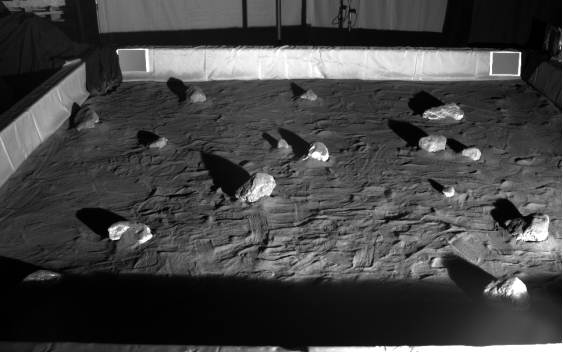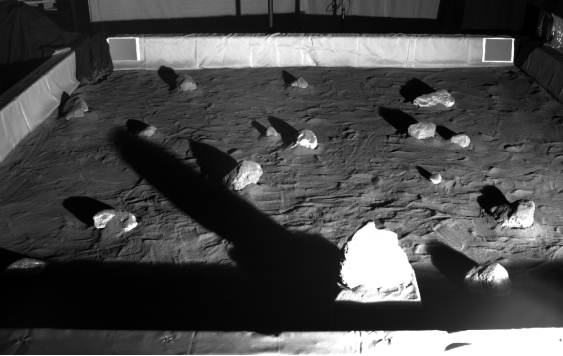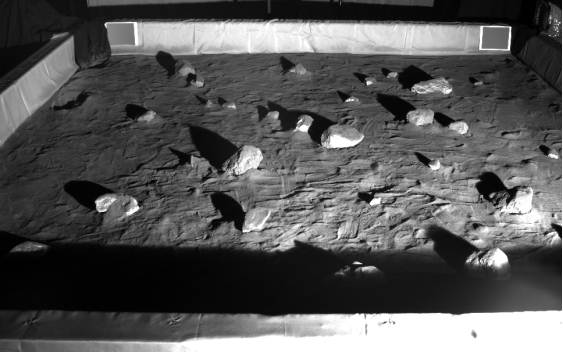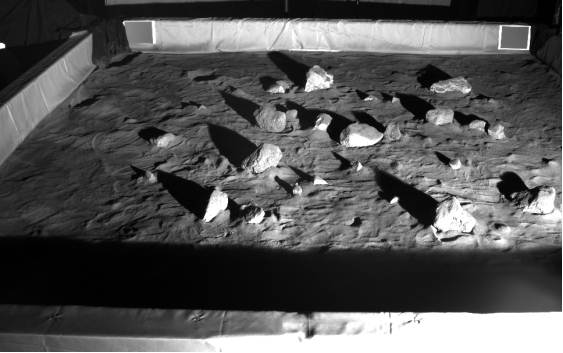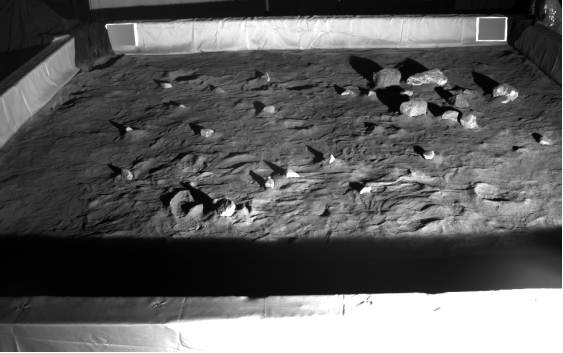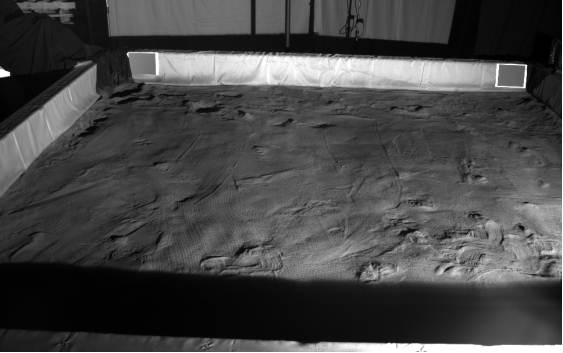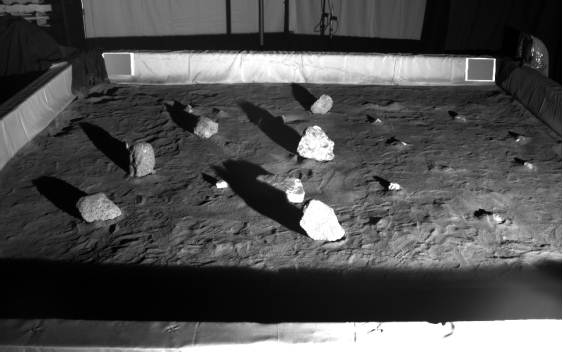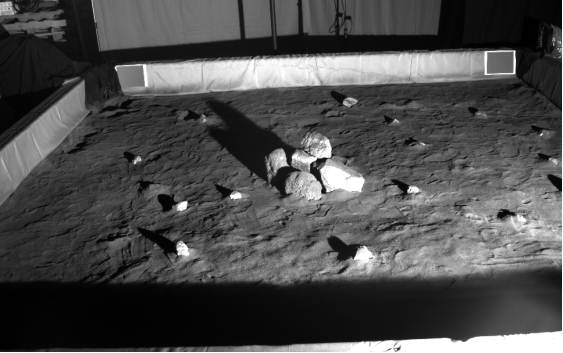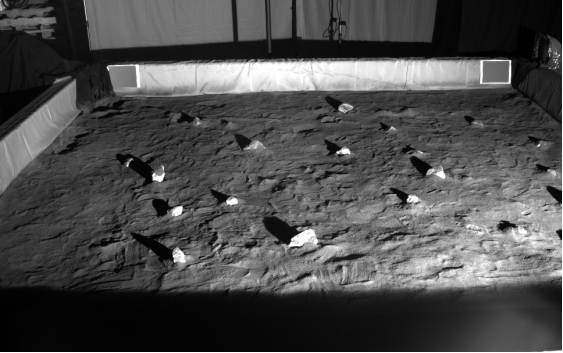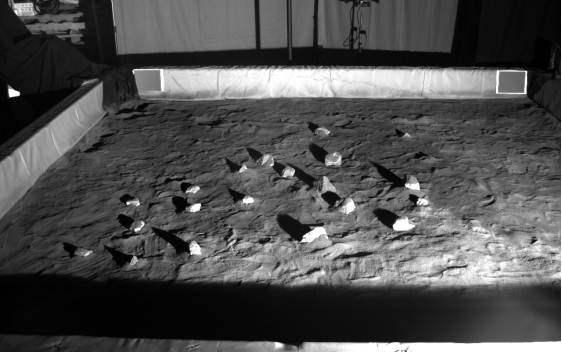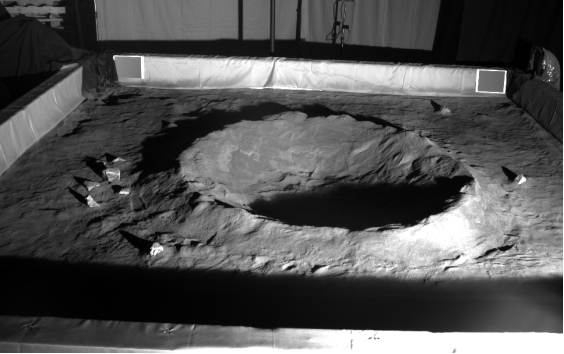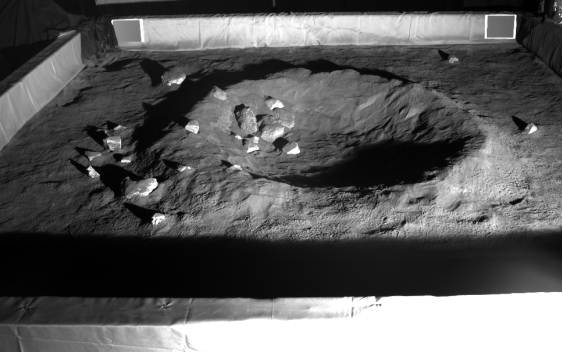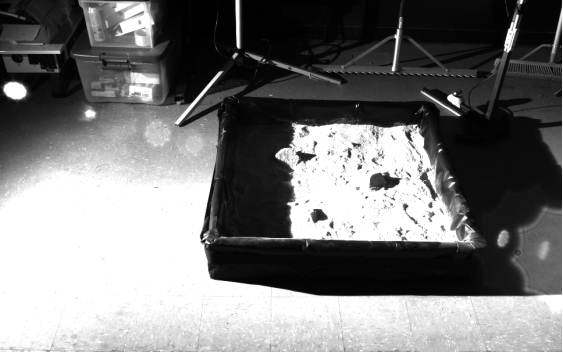You might also
be interested in our newer companion POLAR
Traverse Dataset released in 2023!
Description
The Polar Optical Lunar Analog
Reconstruction (POLAR) dataset seeks to recreate the imaging
conditions at the poles of the Moon for stereo vision evaluation. The
dominant factors of appearance at the Lunar poles are oblique
sunlight, natural terrain, regolith reflectance, and the absence of
atmospheric scattering. Lighting is therefore very harsh, resulting in
long cast shadows and high dynamic range (HDR) conditions due to
contrasting shadowed and illuminated regions. The surface appearance
at the Lunar poles is part of a family of optical environments which
are prevalent on airless bodies throughout the solar system, but
rarely encountered here on Earth.
In developing stereo vision capability
for a proposed NASA mission to the lunar poles, we were surprised to
learn that there was little prior work in the area and almost no
publicly available rover-relevant data on this topic. Despite the
proliferation of robots and the wealth of terrestrial stereo datasets,
few in the robotics community have looked at imaging specific to
airless planetary bodies. In this work, we sought to develop a common
framework for stereo vision researchers: (1) an understanding and
reproduction of polar/airless optical conditions in a laboratory
setting, (2) a library of stereo images for algorithm development
complete with ground truth, and (3) metrics and standards for
comparative evaluation.
For experimentation, analog terrains were constructed in a
laboratory setting using a regolith simulant testbed and populated
with rocks and craters. Each terrain was then illuminated with a
constellation of oblique sun sources and imaged with a stereo rig from
several viewpoints. Finally, a high resolution LIDAR scanner provided
ground truth geometry at sub-2mm accuracy for each image pixel. The
complete dataset comprises 12 terrain experiments - featuring over
2500 HDR stereo pairs and 12GB of sensor data, supplemented with
ground truth, radiometric calibrations, and registration information.

Changelog:
Nov 28, 2023 - Fixed 2 corrupt image files in dataset, made minor
updates to readme, and added link to companion dataset
Nov 01, 2017 - Fixed documentation broken link
May 08, 2017 - Initial Release
Attribution
Citation:
Uland Wong, Ara Nefian, Larry
Edwards, Xavier Buoyssounouse, P. Michael Furlong, Matt Deans, and
Terry Fong. Polar Optical Lunar Analog Reconstruction (POLAR)
Stereo Dataset. NASA Ames Research Center, May 2017.
Our NESF16 poster on the NASA Tech Reports Server [
.pdf].
Acknowledgments:
This work was funded by the NASA Game
Changing Development Program and the Resource Prospector Mission
through the NASA Advanced Exploration Systems Program. Generous
facilities and operational support were provided by the Solar System
Exploration Research Virtual Institute (SSERVI).
We would like to thank Joe Minafra,
Vinh To, Rick Elphic, Tony Colaprete, Greg Schmidt, Bill Bluethmann,
Howard Cannon, Jackie Quinn, Daniel Andrews and the RP team for
advice and support.
Documentation and Support
| Download the dataset documentation
[.pdf]. |
For questions about the dataset,
contact Dr. Uland Wong <uland dot wong at
nasa dot gov> or Dr. Terry Fong
<terry dot fong at nasa dot
gov>.
Primary Dataset
| Download the entire dataset
including extras [.zip,
11.5 GB] or download individual parts below. The individual
parts contain just the images, ground truth LIDAR clouds, and
geometric calibrations. |
Terrain 1
|
|
Description:
This should be an easy hazard detection case. Features a
distribution of rocks that are mostly large and prominent,
with ample spacing in between. The surface has been prepared
with a texture that has undulating features but is relatively
smooth. There are 15 rocks in this terrain.
Download: 730 MB [.zip]
|
Terrain 2
|
|
Description:
Using the same rocks as Terrain 1, but a giant rock has been
introduced into the foreground. The idea is to test a large
area of cast shadow and HDR in the form of a prominent, bright
foreground object. There are 16 rocks (one giant, and 15
large/medium).
Download: 911 MB [.zip]
|
Terrain 3
|
|
Description:
Using the same large rocks as Terrain 1, but small and medium
rocks have been added to the scene in a uniform manner. While
derived from Surveyor 7 (S7) counts, this distribution is
weighted toward larger rocks in order to test hazard
performance. There are 28 rocks in this distribution.
Download: 917MB [.zip]
|
Terrain 4
|
|
Description:
Using the same distribution as Terrain 3, but rocks have been
randomly shuffled to different locations. This distribution is
weighted toward larger rocks in order to test hazard
performance. One side of the terrain has a greater density
than the other. The areal placement of large rocks in this
scene makes it a good test of left-right occlusions in stereo.
There are 28 rocks in this distribution.
Download: 923 MB [.zip]
|
Terrain 5
|
|
Description:
This is an S7 sampled distribution centered on small-medium
sized rocks. A cluster of larger rocks appears in the corner
where it is easily visible from multiple views. This scene
tests hazard detection sensitivity near the 10cm range as well
as accurate detection of larger rocks when they are possibly
arranged with complex shadows. The surface of the regolith is
also contains several small negative features (e.g. pitted,
craters)
Download: 919 MB [.zip]
|
Terrain 6
|
|
Description:
This is a featureless terrain which is thought to be the
hardest case for stereo correlation. The terrain lacks rocks,
though the surface has smooth undulations which may provide
false positives. The surface has been dusted over, however
some brushing and natural texture features remain.
Download: 925 MB [.zip]
|
Terrain 7
|
|
Description:
Large rocks are arranged in a “checkerboard” manner on one
side of the sandbox. Small rocks are arranged randomly on the
opposite side. The side with the small rocks is meant to
simulate a rough-but-traversible area. This scene tests
complex shadows between the large rocks and also shadows cast
from the large rocks onto the the traversible side. There are
19 rocks in this distribution.
Download: 938 MB [.zip]
|
Terrain 8
|
|
Description:
This terrain features a field of small and medium sized rocks
centered on a large boulder. The large boulder is actually a
cluster of rocks stacked together. This scene is designed to
test the effect of a (central rather than peripheral) large
cast shadow on mostly passable terrain. As our large rock has
complex surface geometry with self-occlusions, it is also a
good feature to test stereo reconstruction. There are 16
rocks in this distribution, including one “giant” rock pile.
Download: 927 MB [.zip]
|
Terrain 9
|
|
Description:
This is a distribution of rocks that are at or near the 10cm
hazard limit. The rocks are spaced far apart, with none
touching. This should be a simple, clear test case for hazard
detection. There are 20 rocks in this distribution.
Download: 926 MB [.zip]
|
Terrain 10
|
|
Description:
This terrain uses the same rock distribution as Terrain 9 with
a different placement scheme. Various rocks are clustered in
an area of higher density where many are almost touching,
while areas of the terrain have no rocks. The terrain is
intended to test the effect of areal density of features on
hazard detection/reconstruction accuracy. There are 20 rocks
in this distribution.
Download: 917 MB [.zip]
|
Terrain 11
|
|
Description:
This scene features a large negative obstacle which is meant
represent a smooth "fresh" crater. There are some medium-sized
rocks along the rim and periphery. The relief of the crater is
exaggerated (particularly the rim) in order to also test
detection of steep slopes at the particular angle of view. The
shape of the crater produces interesting interior shadows and
inter-reflected light. The smooth slopes and terrain provide a
correlation challenge case. There are 9 rocks in this
distribution and one crater.
Download: 903 MB [.zip]
|
Terrain 12
|
|
Description:
The fresh crater in Terrain 11 is eroded to create an “old”
crater. The rim is reduced in height and sharpness. Large
rocks lie collapsed along one wall and covered in regolith
while the other side lacks rocks. The regolith has been
surfaced with pockmarks to simulate rough texturing from small
rocks and accumulated micro-impacts. There are 21 rocks in
this distribution and one crater.
Download: 918 MB [.zip]
|
Dataset Extras
Terrain 13
|
|
Description:
This is a small sandbox using the LHT regolith simulant which
is prohibitively expensive for use in bulk. In comparison to
the JSC-1A simulant used in the other terrains, this material
is lighter and closer in appearance to the regolith at the
lunar poles. Three small rocks (~10cm) have been placed in the
scene, and while the light clocks in azimuth. This data is
provided as-is and is not well calibrated.
Download: 202 MB [.zip]
|
Radiometric Calibrations
|
|
Description:
Radiometric camera response functions used to convert pixel
value to scene irradiance. Calibration images, data, and
curves in lookup table format.
Download: 16 MB [.zip]
|
Organized GroundTruth Point Clouds
|
|
Description:
Organized point clouds are 3-channel images mapping 3D LIDAR
scan points to projected locations in a rectified coordinate
system. Useful to compare pixel-wise errors with intensity
images.
Download:380 MB [.zip]
|
Dataset Tools and Code
|
|
Description:
Matlab functions and scripts for programmatically parsing,
loading and manipulating the data.
Note: Due to
software release regulations, we are unable to provide these
files at this time.
|


